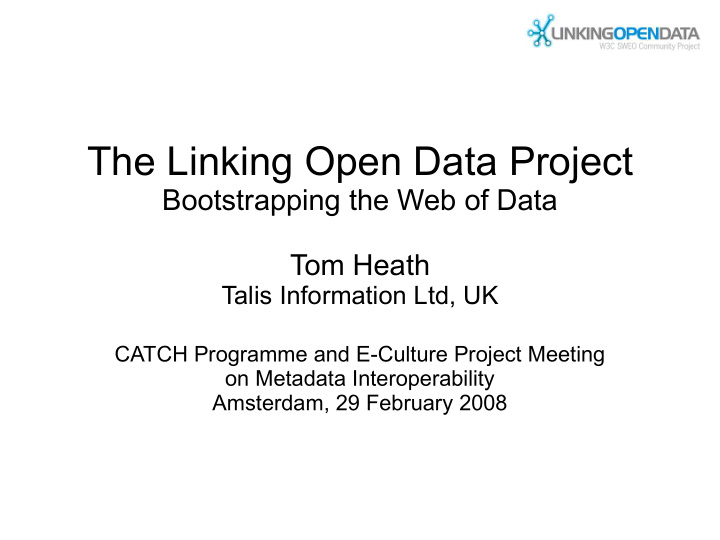



The Linking Open Data Project Bootstrapping the Web of Data Tom Heath Talis Information Ltd, UK CATCH Programme and E-Culture Project Meeting on Metadata Interoperability Amsterdam, 29 February 2008
My Background studiedAt created memberOf worksFor "Talis Platform" makes
Overview ● The Web of Documents and the Web of Data – From global filesystem to global database ● The Linking Open Data Project – Bootstrapping the Web of Data ● Getting Involved
The Web of Documents and the Web of Data
The Web of Documents Analogy ● – a global filesystem Designed for ● – human consumption Primary objects ● – documents Links between ● – documents (or sub-parts of) Degree of structure in objects ● – fairly low Semantics of content and links ● – implicit
The Web of Documents: Issues ● Simplicity ● Loosely structured data, untyped links, disconnected data ● Integration ● Show me all the publications by EPSRC-funded PhD students ● Querying ● Which papers have I written with people from European institutions outside the UK?
Data Silos on the Web
Data Silos on the Web API/ HTML HTML HTML XML A B C D
How do you identify Rembrandt on the Web of Documents? ? ? ? ? API/ HTML HTML HTML XML A B C D
Shared Identifiers support Data Interoperability ● Many common concepts or things need identifiers ● Reusing identifiers links data sets ● Linked data opens the doors of the silos and enables network effects
The Web of Linked Data Analogy ● – a global database Designed for ● – machines first, humans later Primary objects ● – things (or descriptions of things) Links between ● – things Degree of structure in (descriptions of) things ● – high Semantics of content and links ● – explicit
RDF: The Resource Description Framework ● Statements about things ● Triples: subject – predicate – object <tom> <hasPet> <rover> <rover> <type> <dog> <rover> <colour> <brown>
The Linking Open Data Project
The Linking Open Data Project ● Problem – it's getting boring playing with toy examples – we need real data to work with ● Solution – take existing open data sets, convert them to RDF, publish them on the Web and link them together
The Linking Open Data Project ● Started February 2007 by Chris Bizer and Richard Cyganiak ● Supported by the W3C SWEO ● Current Participants – Universities ● FU Berlin, MIT, KMi/The Open University, Universities of Pennsylvania, Leipzig, London, Hannover, Galway, Southampton, Karlsruhe... – Companies ● OpenLink Software, Talis, Zitgist, Joanneum, BBC, Mondeca... – Outreach ● Tim Berners-Lee, Ivan Herman (W3C), everyone...
Linked Data Principles 1. Use URIs to identify things <http://tomheath.com/me> 2.Use HTTP URIs so people can look things up GET /me HTTP/1.0 3.Provide useful data in RDF (preferably reusing ontologies) <http://tomheath.com/me> rdf:type foaf:Person 4.Use RDF to link to other things <http://tomheath.com/me> eg:flewInto <http://sws.geonames.org/6296680/>
The LOD "Cloud" - May 2007 Over 1 billion RDF triples served on the Web Around 120,000 RDF links between data sources
The LOD "Cloud" - May 2007 Over 1 billion RDF triples served on the Web Around 120,000 RDF links between data sources
Spotlight: DBpedia extract structured information from Wikipedia ● make this information available on the Web under an open license ● http://en.wikipedia.org/wiki/Calgary <http://dbpedia.org/resource/Calgary> dbpedia:native_name “Calgary” ; dbpedia:altitude “1048” ; dbpedia:population_city “988193” ; dbpedia:population_metro “1079310” ; mayor_name dbpedia:Dave_Bronconnier ; governing_body dbpedia:Calgary_City_Council ; ...
Spotlight: Geonames ● Contains over eight million geographical names – 6.5 million unique features ● 2.2 million populated places and 1.8 million alternate names ● features categorized into one out of nine feature classes – further subcategorized into one out of 645 feature codes
The LOD "Cloud" - July 2007
The LOD "Cloud" - August 2007
The LOD "Cloud" - Nov 2007 Over 2 billion RDF triples served on the Web Around 3 million RDF links between data sources
The LOD "Cloud" – Feb 2008
Linked Data Applications
Linked Data Browsers
Linked Data Mashups – Revyu
Linked Data Mashups – Revyu
Linked Data Mashups – Revyu
Linked Data Mashups – Revyu
DBpedia Mobile ● Geospatial entry point into the Web of Data ● Uses DBpedia, Revyu and Flickr ● Credits: Christian Becker and Christian Bizer, FU Berlin
Outlook
Queries of the Future ● Whereabouts near my home can I see buildings by architects who were influenced by the Bauhaus? – ...on a Monday? – ...and with a student discount?
Queries of the Future ● Which European city has the greatest concentration of works by Caravaggio? – ...and has direct flights from my home town? – ...with an airline that is rated good or excellent? ● ...by me? ...by my friends?
Getting Involved
Getting Involved ● Which data sets are you responsible for? ● How might these connect to existing "hubs" in the Web of Data? ● Which new "hubs" might you be able to create? ● Get more information via http://linkeddata.org/ ● Add your name to the LOD wiki page ● Join the LOD mailing list and say "Hi" ● Link some data!
Thankyou – Any Questions? ● More info: http://linkeddata.org/ ● My URI: http://kmi.open.ac.uk/people/tom ● Talis Platform: http://www.talis.com/platform ● Slides: ● http://linkeddata.org/slides/2008-02-amsterdam- catch.pdf
Recommend
More recommend